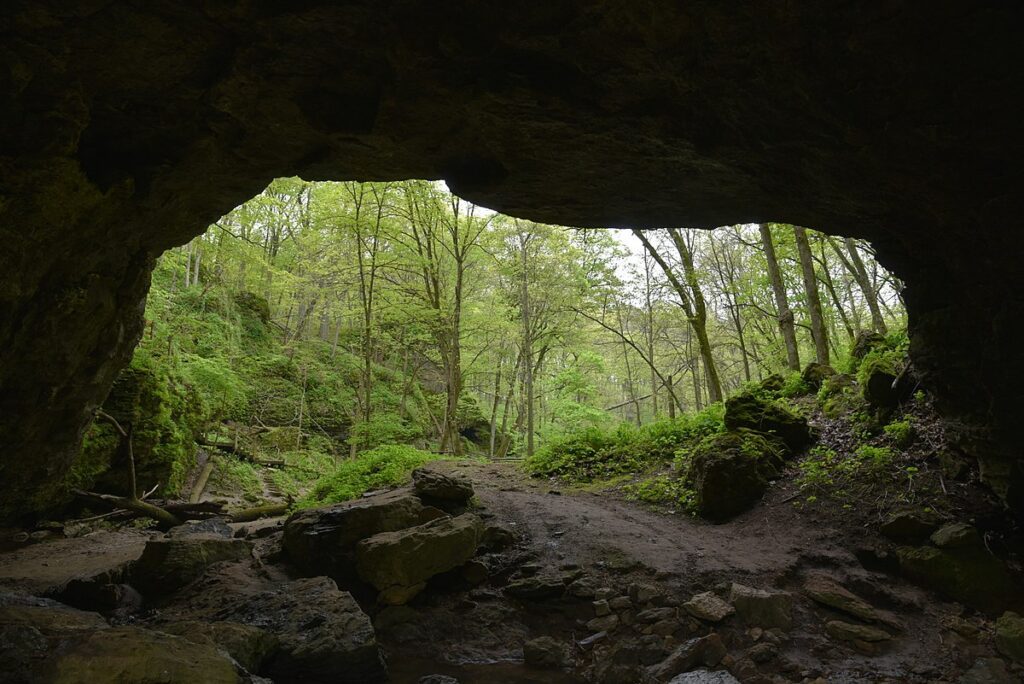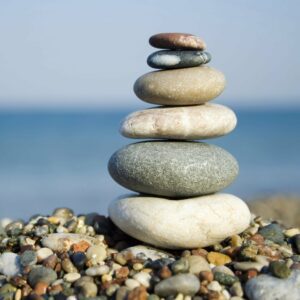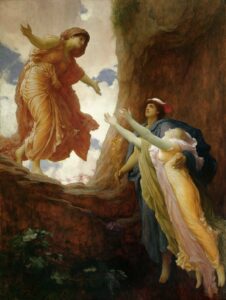Once Coyote crossed the river to the other side, he was further from his home village than he had ever been. The terrain looked strange and unfamiliar, and the sights and smells were confusing to him. He walked on and on throughout the rest of the afternoon. Near twilight, he came upon a cave entrance.
From deep within the cave he could hear the distant sound of drumming and singing. The sound was so faint that for a moment he wondered if he’d heard it at all, or if he’d simply imagined it. He strained his ears to listen.
Yes, it was definitely the sound of chanting from deep within the cave.

Although the thought of journeying into an unknown cave this late in the day filled him with trepidation, the idea of sleeping out in the open in unknown territory with this strange, cold, white substance falling from the sky frightened him even more. He took a deep breath and entered the cave.
As he made his way down the tunnel, he gradually became aware of a faint light in the distance, coming from the direction of the music. He descended down the narrow passageway towards it.
When he arrived at the source of the light, he found himself in a large inner chamber. At the center of the chamber was a fire. The heat from the fire instantly warmed him to the point that he was almost uncomfortably hot. Its light reflected off the crystals that adorned the cavern walls, making shadows and bits of light bounce throughout the chamber. He had never seen anything like this. It was as if the stars of the heavens had come down to the earth and were dancing to the music. And what music it was! It was at once soothing and invigorating; calming, yet disturbing.
As he entered the main chamber he saw a tribe of two-leggeds dancing around the fire. They were all adorned in paint and feathers, and each wore a mask designed to mimic one of the creatures of the earth. There were masks of four-legged creatures like Brother Wolf and Sister Cougar, and masks of the creatures of the air like Brother Eagle and Sister Wren. There were also masks in the likeness of the fishes, like Sister Salmon and Brother Trout. All the creatures of the three realms of earth, air, and water were represented.
As Coyote watched the dance, he noticed something unusual: All of the dancers were circling the fire backwards. They danced in a spiral, moving in the direction opposite of the way their masks were facing.
“This is very strange!” thought Coyote. He settled down to watch the dance so that he might glean from the performance what his next move might be.
He lay down on the cavern floor to watch. He tried his best to stay awake, but the warmth of the fire and the surreal quality of the music, combined with the rhythmic motions of the dancers, soon conspired to lull him into a trance, and he fell fast asleep.
As he dreamed, he pondered the quest. He was full of self-doubt. “I’m just a Coyote. I can’t do this,” he kept saying to himself. “I haven’t the skills or the strength to complete this mission!”
As he lay dreaming and thinking about these things, he was startled by the sound of screaming. The two-leggeds had stopped dancing, and they were all rushing towards him! One grabbed his hind legs, another grabbed his forepaws, another seized his tail, and yet another grabbed him firmly about the neck. They began to pull, still screaming at him, until he came apart and his body was ripped to pieces!
He awoke on the cold ground with a
start. He quickly checked himself to discover that he was still in one piece.
It was only a dream, but it had seemed so real! He had thought himself dying.
The illusion was so complete that upon waking he was actually puzzled to find
himself still alive.
5.0 Who are You? Centering Yourself
Why are you, you? What are the things that make you the person that you are today? Why do the inner work required by ecospirituality in the first place?
Many of us carry a vision of who we would like to be. We also carry a vision of who we perceive ourselves to be at this moment in time. The Humanist Psychologist Carl Rogers called these two visions the Ideal Self and the Perceived Self. At the times when we do not feel at peace with ourselves because of some anxiety, stress or depression, it is most often due to a conflict between our vision of who we would want to be, and who we actually perceive ourselves to be. In other words, we experience a conflict between the Ideal Self and the Perceived Self.
The act of centering involves striking a balance between the powers of chaos and order in our lives. From this perspective, the Ideal Self represents the power of order, and the Perceived Self represents the power of chaos. The way to strike a balance between these two powers is to introduce a little chaos into the order, or introduce a little order to the chaos.
If conflict and inner turmoil are arising within you because of the gap between your Ideal Self and your Perceived Self, then the way to achieve balance would be to narrow that gap or to close it completely. Suppose for example that your Ideal Self is a person who is organized, punctual and capable of completing multiple tasks at once during the day. On the other hand, your Perceived Self (the person you see yourself as) is not very organized, always late, and incapable of meeting all the goals you set for yourself in a day. The conflict within you has arisen in this case because you have set impossible standards for yourself, yet you feel you should be able to meet those standards anyway. One way to find balance in this situation would be to realize that your Ideal Self doesn’t have to be perfectly organized and punctual all the time, thereby allowing a little chaos to enter into the “perfect’” order established in your vision of your Ideal Self. Another way to introduce balance is to impose a little more order upon the chaos of your Perceived Self by taking the time to plan better so that you are more able to meet the schedule set by your Ideal Self.
The ultimate goal of the inner journey that is the Way of the Coyote is to strike a balance between the Ideal Self (or the life of perfect order) and the Perceived Self (or the life of perfect chaos). The more we learn about our own inner wants, needs and desires, and the reasons for them, the more we will draw closer to achieving the balance of individuation. In short, if we can change our thoughts and feelings, we can change the world. But in order to change our thoughts and feelings, we must first know what those thoughts and feelings are. Centering is a way to learn about your thoughts and feelings so that you may change them if you so desire.
There are many things we may wish to change about ourselves and about the world. We may even be able to change many of them. But there are also things that are beyond our power to change. Those things we cannot change, we must learn to accept. If we do not, then we will be endlessly frustrated by attempting the impossible. Of course, it can be very difficult to tell which things we can change, and which things we cannot. This is where wisdom enters the picture. One purpose of centering is to gain enough inner wisdom to be able to know the difference between the things we can change, and the things we must accept.
Think for a moment about the last time you were anxious or stressed out. Do you remember what caused your anxiety? Did that cause of your worry have something to do with an event that happened in the past, or an event that might happen in the future? Until someone invents a time machine, there is no way to go back and change the past. So worrying about something that happened in the past is counterproductive. Likewise, if you are worrying about something that may or may not happen in the future, you are wasting energy that could be put to better use in the here and now. Unless you have a crystal ball, there’s no way of knowing for certain what may happen in the future. By worrying about it, you are expending energy that could be used to prevent the possible future disaster from happening in the first place.

When stress arises within us due to conflicts between our Ideal Self and our Perceived Self, we can restore balance and eliminate or reduce that conflict by seeking wisdom through acceptance and change. If there is something we cannot accept, then we must change it. If there is something we cannot change, we must learn to accept it. These are the only two choices we have. The wisdom comes in knowing whether a thing is something that can be changed, or if it’s something we have to accept.
If the conflict between our Ideal Self and our Perceived Self has to do with something that happened in the past or something that might happen in the future, then that is something we will have to learn to accept, since it is impossible to change the past, and it is impossible to predict the future with any degree of certainty. The only changes we may make involve things that are happening right now, in the present moment.
Remember, as you set out on the path of making changes in your life, that you cannot change anyone but yourself. If problems arise in your life because of the actions of another person, you cannot force that person to do anything. All you can do is to accept that they are who they are. Knowing this, you may then be able to change yourself so that you can accept others more easily. This acceptance can occur more readily if you learn to let go of the past and the future and focus only on the present moment.
5.1 Dying to the Old Ways of Being
The problem with crossing the first threshold is that it is stepping into the unknown. The unknown is unfamiliar. We don’t know the rules. We don’t know what’s expected. We don’t know how to act. We don’t know the dangers. We don’t know what to assume about the way the world works now.
In order to learn new ways of being, we must first cast off our assumptions about the way things worked before. Our assumptions create our perceptions, and our perceptions create our reality. If we’re journeying to new realities, our old perceptions and assumptions have to be discarded. This can be an especially difficult task, since many of our assumptions and perceptions are involved in our own sense of identity. If we cast them off, we might lose who we are. But in order to become someone new, we must lose who we were before. We must die to our old ways of being. We must be willing to bury old ways of doing. We must cast off old assumptions and perceptions so that we may gain a new reality.
Jonah spent three days in the Belly of the Whale after his Refusal of the Call. This was Jonah’s casting off of his former identity so that he could step into his new role as a spiritual leader. This time in the whale’s belly is a time of reflection and of challenging preconceived notions before initiation into a wider world. It is the preparation for the death of the old in order that the new may be born.
5.2 Finding a New Truth
“Your vision will become clear only when you can look into your own heart. Who looks outside, dreams; who looks inside, awakes.”
-Carl Jung
“The truth will set you free, but first it will piss you off.”
-Gloria Steinem
There is a Zen koan about a student who came to a Zen Master for training. The student wanted to impress the master with his knowledge, so he talked non-stop for several minutes about the previous masters he had studied with, and all the knowledge he had accumulated. As the student talked, the Master offered him a cup of tea. The Master, still listening intently, placed the cup before the student and began to fill it. When the cup was filled, the Master continued pouring until the tea ran out of the cup, onto the table, and into the student’s lap. The student yelled for the Master to stop pouring the tea, “Can’t you see that the cup is full? There’s no room for any more tea!”
“Yes,” the Master replied, “Once the cup is full, it cannot be filled any further. You come to me to learn, but I cannot teach you. Your cup is already full. You must first go and empty your cup. When you have done this, then I can fill it again.”
In Phase One of the Hero’s Journey, the Departure, we learned what it means to seek a new spiritual path by leaving the familiar behind. In Phase Two, the Initiation, we will learn what it means to die to the old ways of being and to be reborn as a spiritual seeker and a follower of the Way of the Coyote. Like the student with the full cup, a seeker on the Way of the Coyote must first empty her cup of all other teachings. This means forgetting old ways of being. It means casting aside any assumptions or perceptions about what may lie ahead on the path. To die to the old ways of being means to erase the past, letting go of any preconceived notions about the way the world worked in the past. It means starting over in every sense of the word.
There are three components of this rebirth: Assumptions, Intentions, and Motivations (think of the word AIM to help you to remember these three components). Before you can be reborn to the Way of the Coyote, you must address all three of these components in the following ways:
Assumptions – What assumptions were you living by before answering the Call of the Coyote? How are these assumptions different from the assumptions you would need to live by in order to answer the call? What assumptions might you have been making about your old life that were leading to problems? What new assumptions, if any, would you need to make in order to be reborn? In order to follow the Way of the Coyote?
Intentions – What was your intention in living the way you did prior to answering the Call of the Coyote? What were you trying to accomplish? What were your goals then, and how will your goals be different when you answer the Call of the Coyote? What is your intention in seeking the Way of the Coyote? What do you hope to accomplish?
Motivations – What were your motivations for living the way you did prior to answering the Call of the Coyote? What were the rewards for your old way of living? Were those rewards spiritual or material? What will be the rewards (motivations) for answering the Call of the Coyote? Will these motivations be spiritual or material? Are you prepared to make the sacrifices necessary to follow the Call of the Coyote? If so, what will the rewards be? If not, what’s standing in your way?
When you are able to answer all of these questions honestly you will be ready to leave the cave. You will have found a new truth to live by, and this new truth shall be your road map on the Way of the Coyote.
5.3 Katabasis
“The word ‘ashes’ contains in it a dark feeling for death; ashes when put on the face whiten it as death does…some men around thirty-five or forty will begin to experience ashes privately, without ritual, even without old men. They begin to notice how many of their dreams have turned to ashes.”
–Robert Bly, Iron John: A Book about Men

Katabasis is Greek for “to go down” or “to descend.” To be in the Belly of the Whale is to engage in your own personal katabasis. It is a realization that the way you have lived your life up to this moment is not in accordance with your own true nature. If this were not so, you wouldn’t have taken up the Way of the Coyote in the first place. Katabasis means asking yourself, “If nothing changed from this day forward, could I live the rest of my life this way?” If the answer to that question is, “no,” then obviously something must change. In katabasis, change happens when the fear of staying the same forever becomes greater than the fear of changing forever by taking the journey into the unknown.
The way to escape the Belly of the Whale is by completing the process of katabasis. To explore one possible way of doing this, complete the exercise on the worksheet below.

